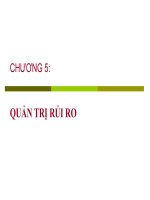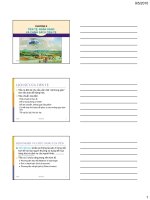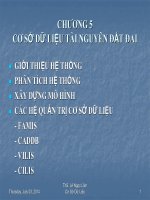Bài giảng Electrical and electronic principles: Chương 5 - ThS. Ngô Quốc Cường
Bạn đang xem bản rút gọn của tài liệu. Xem và tải ngay bản đầy đủ của tài liệu tại đây (709.81 KB, 22 trang )
TRƯỜNG ĐẠI HỌC SƯ PHẠM KỸ THUẬT
TP. HỒ CHÍ MINH
ELECTRICAL AND ELECTRONIC
PRINCIPLES
WEEK 5
Cuong Q. Ngo
Last classes
• Maximum power transfer
• MATLAB fundamentals
• Single frequency AC analysis (MultiSim)
2
CONTENTS (Today)
• Magnetically coupled circuits
• Transformer
• Resonance
3
1.Magnetically coupled circuits
• Mutual inductance
– Mutual inductance is the ability of one inductor to induce a
voltage across a neighboring inductor, measured in henrys
(H).
– If a current enters the dotted terminal of one coil, the
reference polarity of the mutual voltage in the second coil
is positive at the dotted terminal of the second coil
4
1.Magnetically coupled circuits
• If a current leaves the dotted terminal of one coil, the
reference polarity of the mutual voltage in the second coil is
negative at the dotted terminal of the second coil
•
5
1.Magnetically coupled circuits
• Model
6
1.Magnetically coupled circuits
• Example 1
• Calculate the phasor currents I1 and I2
7
1.Magnetically coupled circuits
• Answer
I1 13.01 49.39 A
I 2 2.9114.04 A
8
2. Transformer
Courtesy: Jensen Transformers
9
2. Transformer
• Ideal transformer
– Coils have very large reactances
– Coupling coefficient is equal to unity
– Primary and secondary coils are lossless
10
2. Transformer
• Typical circuits illustrating proper voltage polarities and
current directions in an ideal transformer.
11
2. Transformer
• Input impedance
• Complex power supplied by the source
12
2. Transformer
• Example
Find Vo and complex power supplied by the source
13
2. Transformer
• Answer
14
3. Resonant circuits
Series resonance
• Resonance is a condition in an RLC circuit in which the
capacitive and inductive reactances are equal in magnitude,
thereby resulting in a purely resistive impedance.
• The value of 𝜔 that satisfies this condition is call resonant
frequency 𝜔𝑜
15
3. Resonant circuits
• Half-power frequencies
• Relate the half-power frequencies with the resonant
frequency
• Bandwidth
16
3. Resonant circuits
• Amplitude of current
– At 𝜔 = 𝜔𝑜
– At 𝜔 = 𝜔1
17
3. Resonant circuits
• The quality factor of a resonant circuit is the ratio of its
resonant frequency to its bandwidth.
18
3. Resonant circuits
• Example
• With R = 2 Ω, L = 1 mH, C = 0.4 µF
• Find the resonant frequency and half-power frequencies
• Calculate the quality factor and bandwidth
• Determine the amplitude of current at 𝜔𝑜 , 𝜔1
19
3. Resonant circuits
• Answer
• 50 krad/s; 25; 2 krad/s; 10 A; 7.071 A
20
3. Resonant circuits
Parallel resonance
• Resonant frequency
21
3. Resonant circuits
Parallel resonance
• Half-power frequencies, bandwidth, and quality factor
22









